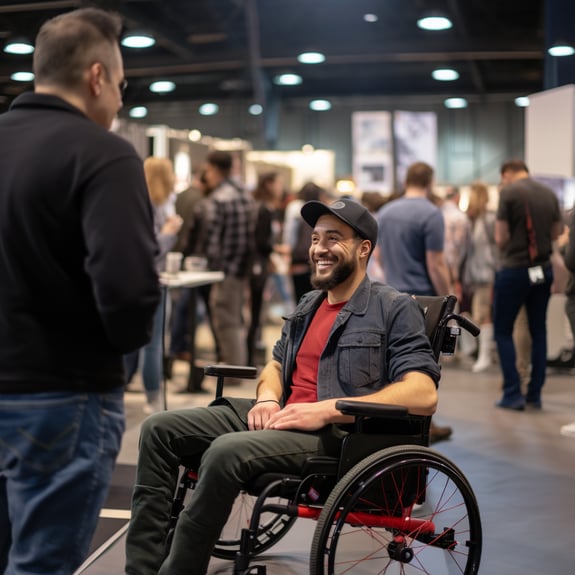Inclusivity and accessibility are crucial elements that are often overlooked in the rush of trade show planning. Yet, creating an environment that welcomes all attendees, regardless of their physical abilities or generational differences, is not just about compliance or ticking boxes—it's about extending your brand's reach and resonating with a broader audience.
As we move into 2024, the focus on diversity, inclusivity, and accessibility becomes even more pertinent, reflecting broader societal shifts towards equality and universal access. Ensuring your trade show booth is designed with these principles in mind is not only ethically right but also strategically smart, enhancing brand perception and engaging a wider demographic.
Let’s take a look at some strategies for creating an inclusive and accessible trade show experience.
Designing for Physical Accessibility:
Ensuring your booth is physically accessible to people with disabilities is a fundamental step. This includes providing ramps for wheelchair users, having information available in Braille for the visually impaired, and ensuring all interactive elements are within reach for everyone.
Consideration of space layout to avoid crowding and ensure ease of movement for those with mobility aids is also crucial. These adjustments make your booth welcoming to attendees with various physical needs, demonstrating your brand's commitment to accessibility.
Incorporating Multi-Generational Engagement:
Understanding the diverse expectations and communication styles of different generations—Gen Z, Millennials, and Boomers—is key to engaging a broad audience.
For example, while Gen Z might be drawn to interactive digital displays and social media integration, Boomers may appreciate more traditional, personal interactions and clear, accessible information without the need for technological interaction.
Millennials, straddling the digital and traditional worlds, might appreciate a blend of both.
Tailoring your booth's design and engagement strategies to cater to these varied preferences ensures that your message resonates across age groups.
Utilizing Technology for Inclusivity:
Leveraging technology can greatly enhance inclusivity. For instance, providing QR codes that link to online content can help visually impaired attendees access information via screen readers.
Similarly, offering sign language interpretation services through AR glasses or having live captioning for presentations ensures that attendees who are deaf or hard of hearing can fully engage with your content.
Training Staff on Diversity and Inclusion:
Having a well-trained staff who are aware of diversity, inclusivity, and accessibility issues is invaluable.
They should be prepared to interact with all attendees respectfully and effectively, whether it involves understanding how to communicate clearly with someone who is hard of hearing or knowing how to assist someone with a mobility aid.
Feedback and Continuous Improvement:
Actively seeking feedback from attendees about their experience at your booth regarding accessibility and inclusivity is essential for continuous improvement.
This can be facilitated through digital surveys or suggestion boxes. Listening to the experiences of a diverse range of attendees will provide insights into how to better tailor your booth in the future.
Elevating Your Brand with Exhibit Options
Creating a trade show booth that is inclusive and accessible to all attendees is not just a moral imperative—it's a strategic advantage that elevates your brand as thoughtful, progressive, and customer-centric.
At Exhibit Options, we specialize in designing and building trade show booths that reflect these values, ensuring your brand stands out for all the right reasons.
Partner with us to create a trade show experience that truly welcomes everyone, making every attendee feel valued and engaged.
Together, we can set a new standard for inclusivity and accessibility in trade show planning for 2024 and beyond.



COMMENTS